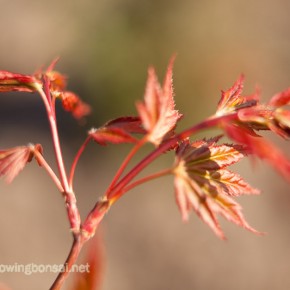
Acer Palmatum, or Japanese maple, is a species of small-leaved maples. Several hundreds of varieties exists and this is one of the traditional bonsai species most used worldwide.
Position is in filtered sun, out of hot winds. The leaves are delicate and burn easily. Therefore shield the tree against direct summer sun, and make sure dry summer winds can’t reach the plant. Otherwise within a few hours green foliage may turn in crisp. (However, the species itself is hardy and will regrow after such an event).
Water and soil. Acer palmatum in general are water lovers. They prefer to keep their roots fairly moist (Note: This does not mean you keep the soil soaking with water; Rather, ensure the rootball does not completely dry out). Therefore, when repotting use good quality soil such as acadama, or another well-draining mix with some moisture-retaining substrate, such as bark or coco-peat.
Recognizing. Acer palmatum forms delicate branches with opposite buds. The leaves may have 5, 7 or 9 lobes. These lobes may form an almost complete leave, or may be heavily serrated as can be seen in the laceleaf palmatum varieties.
Not to mix up with other acer species, particularly the trident maple, or Acer buergerianum. Clear difference is in the number of lobes in the leave (three rather than 5+) and the bark (Palmatum has a very smoot bark, whereas trident maple bark gets very textured with time.
Noteworthy. Many palmatum varieties are grafted onto a wild rootstock. This is less suitable for bonsai as the graft will never disappear; With time it may even become more pronounced due to differences in grown speed. Only very few Palmatum varieties grow true from seed. As it may be deficult to get cuttings to strike, reproduction is for most private persons best done through layering or air-layering.




